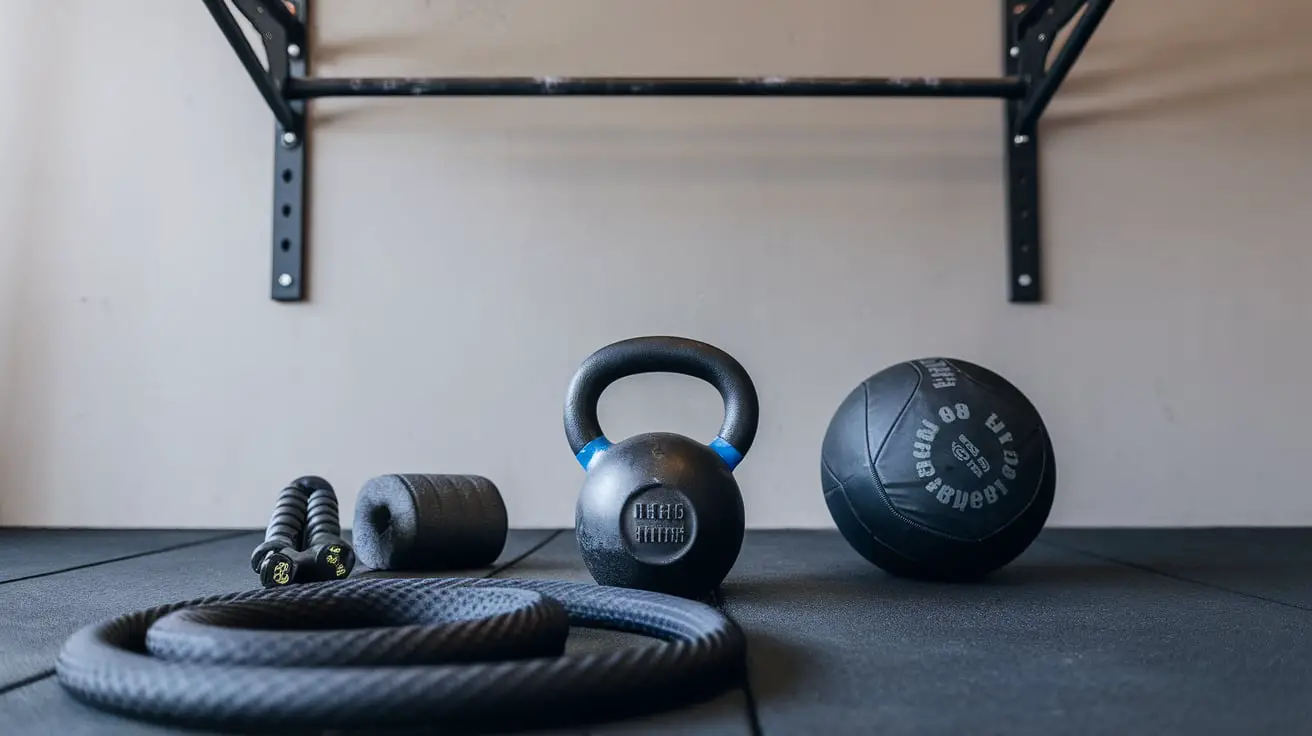Creating a home Crossfit setup opens up a world of fitness possibilities right at your doorstep. No more rushing to the gym during peak hours or waiting for equipment to free up. A well-planned home gym gives you the freedom to work out whenever you want, while saving time and money on monthly memberships.
Setting up your own Crossfit space requires careful planning and smart choices. The key lies in selecting versatile equipment that serves multiple purposes and fits your available space. From basic essentials to more advanced gear, each piece should contribute to your fitness goals while staying within your budget.
The following sections will guide you through selecting the most effective Crossfit equipment for your home gym. We’ll explore everything from essential strength training tools to cardio equipment, plus clever storage solutions that maximize your workout space. Let’s discover how to build a practical and efficient home gym that matches your fitness aspirations.
What Equipment Do You Really Need to Start?
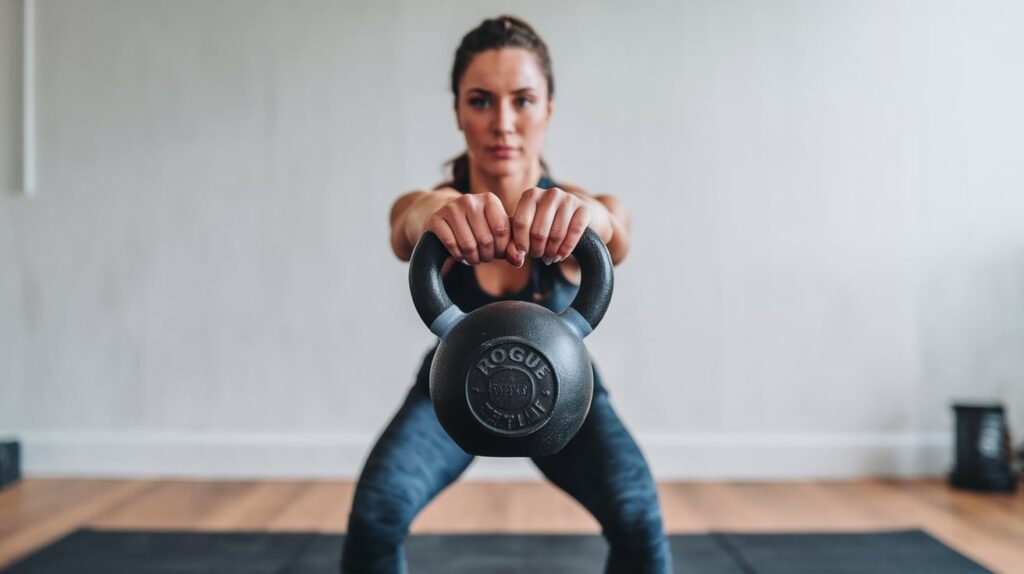
Starting a home Crossfit setup doesn’t require a complete gym overhaul. The right combination of basic equipment can create an effective workout space that fits your needs and budget. Your initial investment should focus on versatile pieces that offer multiple exercise options.
Must-have Basics for Beginners
The foundation of any home Crossfit setup starts with simple, fundamental pieces. A quality jump rope and a set of resistance bands provide countless workout possibilities. These lightweight tools take up minimal space yet deliver maximum results for both cardio and strength training.
Think about your fitness goals before purchasing equipment. What movements do you want to practice most? Which exercises appear frequently in your preferred workout routines? Your answers will help guide your equipment choices.
Core Equipment for Strength Training
Strength training forms the backbone of Crossfit workouts. A set of adjustable dumbbells serves as an excellent starting point, allowing you to modify weights as needed. Add a pull-up bar that mounts securely to your doorframe or wall – this single piece opens up numerous upper body exercise options.
Here are the essential strength training items to consider:
- Adjustable dumbbells (5-50 lbs range)
- Pull-up bar
- Kettlebell (16-24 kg)
- Weight plates (start with 2.5-45 lb pairs)
- Barbell with collars
Essential Cardio Equipment
Cardio equipment needs vary based on your space and preferences. A quality jump rope costs little but provides intense cardiovascular workouts. If space permits, an air bike or rowing machine offers full-body cardio options that complement strength training perfectly.
Versatile Tools for Multiple Exercises
Multi-purpose equipment maximizes your workout options while minimizing space requirements. A sturdy plyo box serves for box jumps, step-ups, and elevated pushups. Gymnastics rings add variety to pulling movements and can hang from your pull-up bar.
The beauty of these tools lies in their adaptability. A single resistance band can assist with pull-ups, add difficulty to pushups, or provide resistance for muscle-building exercises.
Budget-friendly Alternatives
Smart shopping can help build your home gym without breaking the bank. Second-hand marketplaces often list quality equipment at reduced prices. Many exercises can be modified using household items or less expensive alternatives while you build your collection.
Start with the basics and add pieces gradually. This approach helps you understand which equipment you use most frequently and where to invest more substantially. Focus on quality over quantity – one well-made piece will outlast several cheaper alternatives.
Your workout space should grow with your abilities. Begin with fundamental pieces that support basic movements, then expand your collection as your skills and strength improve. This strategic approach creates an efficient, practical home gym that serves your fitness journey.
Which Strength Equipment Delivers the Best Results?
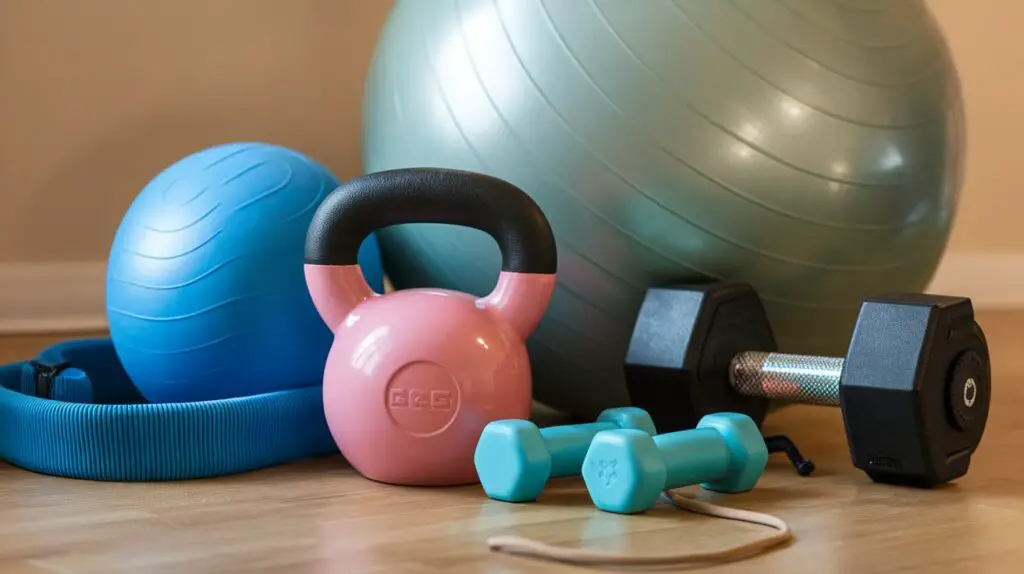
Selecting the right strength equipment can make or break your home workout success. Quality gear supports proper form, prevents injuries, and helps you achieve your fitness goals faster. Let’s explore the most effective strength training tools for your home gym setup.
Barbell and Plate Selections
Olympic barbells stand out as the cornerstone of strength training. A high-quality bar weighs 45 pounds (20kg) for standard models and 35 pounds (15kg) for women’s versions. The key features to look for in a barbell include:
- Tensile strength above 190,000 PSI
- Dual knurl marks for proper grip placement
- Smooth spinning sleeves
- Rust-resistant coating
Weight plates deserve careful consideration too. Start with a set that includes pairs from 2.5 to 45 pounds. Bumper plates, made from dense rubber, allow safe dropping during Olympic lifts and protect your floor from damage.
Rack and Rig Options
A power rack creates a safe environment for heavy lifting at home. The most practical option for limited spaces is a wall-mounted folding rack. These systems fold flat against the wall when not in use, freeing up valuable floor space.
Safety should guide your rack selection. Check the weight capacity and stability before purchase. A good rack needs j-cups for barbell storage, safety pins or straps, and pull-up bars built into the frame.
Kettlebell Recommendations
Kettlebells offer dynamic workout possibilities through their offset center of mass. For beginners, a 16kg (35lb) kettlebell provides enough resistance for most movements. More advanced athletes might need a set ranging from 12kg to 32kg.
The handle size and finish matter significantly. Your grip should feel comfortable during swings and other movements. Cast iron kettlebells with a powder coat finish provide the best grip while preventing rust.
Dumbbell Choices
Fixed dumbbells vs adjustable sets – this choice depends on your space and budget. Adjustable dumbbells save space but take time to modify between exercises. Traditional fixed pairs allow quick weight changes during circuit training.
For most women starting strength training, a set ranging from 5 to 30 pounds covers most exercises effectively. The dumbbells should have knurled handles for secure grip and hexagonal heads to prevent rolling.
Weight Storage Solutions
Organization keeps your workout space safe and efficient. A weight tree or plate storage system prevents plates from becoming trip hazards. Consider these storage priorities:
- Vertical storage to maximize floor space
- Easy access during workouts
- Protection for your equipment
- Weight distribution to prevent tipping
- Clear labeling system
Proper storage extends equipment life and maintains workout flow. Wall-mounted plate storage pairs well with folding racks, while mobile weight trees offer flexibility in placement. Your storage solution should match your workout style and available space.
A systematic approach to organizing weights reduces workout interruptions. Group similar weights together and position frequently used items at easily accessible heights. This setup minimizes transition time between exercises and maintains workout intensity.
How to Choose the Right Cardio Equipment?
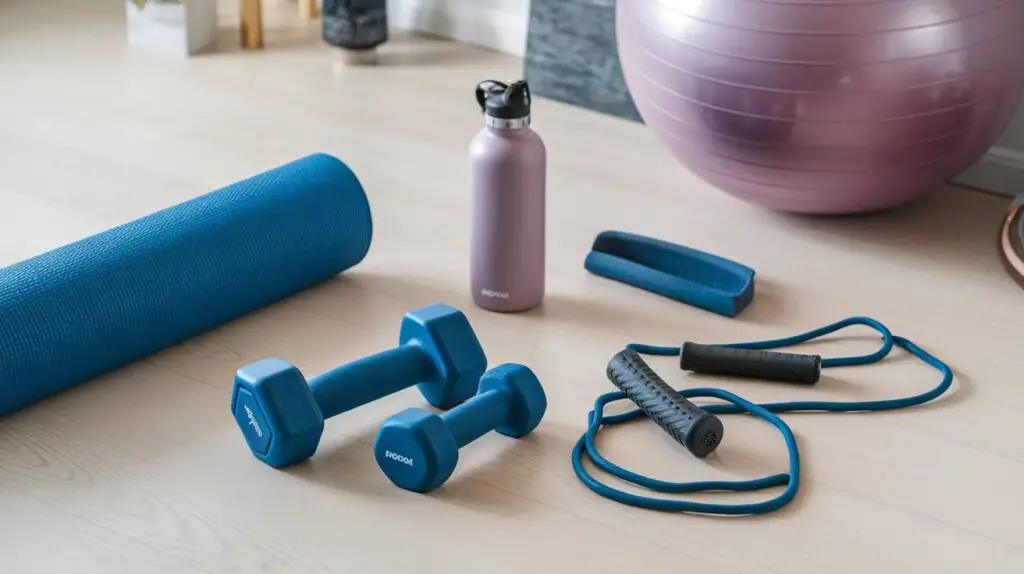
Selecting the right cardio equipment can transform your home workouts from good to great. Your choice should match your fitness goals, available space, and preferred workout style. Let’s explore the most effective options for your home gym setup.
Air Bike Comparisons
The Rogue Echo Bike and Assault Bike lead the market in quality and performance. The Echo Bike’s reinforced steel frame eliminates swaying during intense sprints, while its belt-driven system provides smooth resistance. The Assault Bike Pro offers Bluetooth connectivity and pairs with fitness apps for guided workouts.
These machines deliver different experiences – the Echo Bike provides more resistance at higher speeds, making it ideal for short, intense bursts. The Assault Bike offers a smoother ride, perfect for longer endurance sessions.
Rowing Machine Options
The Concept2 RowErg stands out as the industry standard, supporting users up to 500 pounds with its durable construction. Its variable resistance flywheel adapts to your effort level, making it suitable for both beginners and advanced athletes.
Modern rowers like the Hydrow Wave add technology to the mix with HD screens and guided workouts. Consider these key factors when choosing your rower:
- Space requirements and storage options
- Noise level preference
- Budget constraints
- Training style (technique focus vs entertainment features)
- Resistance type (air, magnetic, or water)
Jump Rope Selections
A quality jump rope can revolutionize your cardio routine. The Amazon Basics Standard Jump Rope offers excellent value with its adjustable 9-foot length and smooth ball bearings. For speed work, look for ropes with PVC-covered wire, which prevents tangling and maintains shape during fast movements.
Conditioning Tools
Air bikes excel at improving cardiovascular health while building strength. They work multiple muscle groups simultaneously, making them efficient tools for HIIT workouts. The dual-action design engages both upper and lower body, maximizing calorie burn in shorter time periods.
Space-efficient Alternatives
Small spaces need smart solutions. A folding treadmill or wall-mounted rowing machine can save precious floor space. Jump ropes offer perhaps the most compact option, providing intense cardio benefits while storing away in minimal space.
Your workout area’s size shouldn’t limit your fitness progress. Consider vertical storage options and equipment that serves multiple purposes. A single air bike can replace several pieces of traditional cardio equipment, offering both strength and endurance benefits.
The best cardio setup combines versatility with practicality. Focus on equipment that matches your workout style and space constraints. Quality matters more than quantity – one well-chosen piece will serve you better than several mediocre options.
Smart Storage Solutions for Your Home Setup
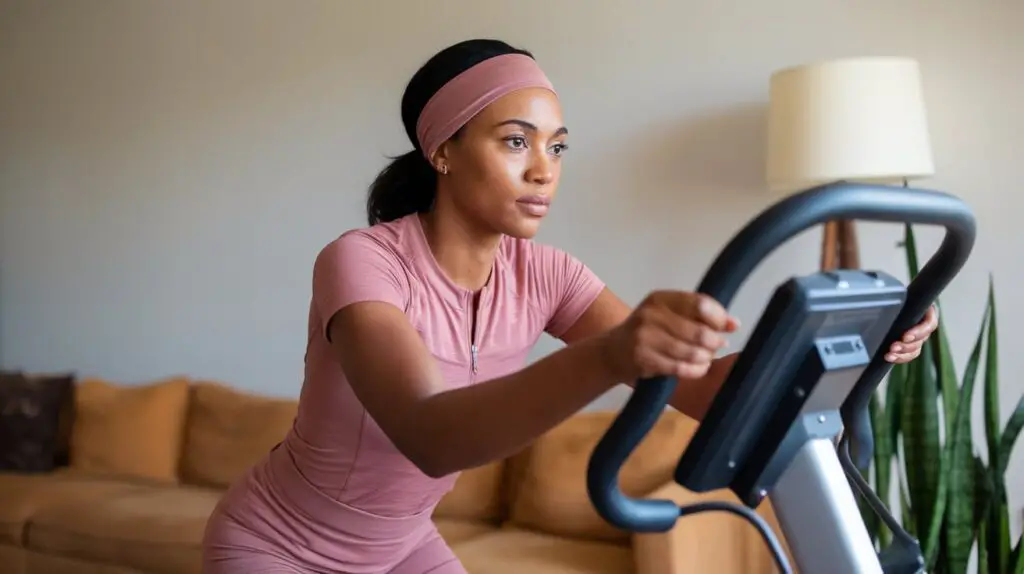
A well-organized home gym creates an efficient workout environment and prevents accidents. Strategic storage solutions can double your available space while keeping equipment easily accessible. Here’s how to optimize your workout area.
Wall-mounted Organization
The Wall Control system transforms empty wall space into a functional storage area. This steel pegboard system holds up to 200 pounds per panel and offers countless configuration options. Mount resistance bands, jump ropes, and smaller accessories where you can easily grab them during circuit training.
Your walls can handle more than just a pegboard. Consider these proven storage solutions for your equipment:
- Heavy-duty hooks for medicine balls
- Vertical barbell holders
- Adjustable shelving units
- Band pegs and hangers
- Equipment organizer racks
Vertical Storage Ideas
Going vertical maximizes floor space in compact areas. Install tall storage units or stack modular shelving systems to utilize ceiling height effectively. The Rogue 3-Tier Mass Storage System offers expandable options for dumbbells, kettlebells, and other heavy equipment.
Equipment Protection Tips
Proper storage extends equipment life and maintains performance. Keep cardio machines covered between sessions to prevent moisture damage. Apply mineral oil monthly to steel components, especially in humid environments. For rubber equipment, use UV protectant spray to prevent degradation from sun exposure.
Flooring Considerations
Quality flooring protects both your equipment and building structure. The Flooring Inc 8mm rubber rolls provide excellent durability and sound dampening. Install proper flooring before setting up storage systems to create a stable foundation for heavy equipment.
Space Maximization Strategies
Small spaces need smart solutions. Foldable equipment like collapsible racks and adjustable benches open up floor space when not in use. Position frequently used items at easily accessible heights to maintain workout flow.
Multi-purpose storage units serve double duty. A sturdy weight storage system can also function as a dip station or pull-up bar. Look for equipment with built-in storage features to reduce the need for additional organization tools.
The FizLig storage rack exemplifies efficient design, offering multiple prongs for various equipment types while taking minimal wall space. This type of versatile storage solution keeps your workout area tidy without sacrificing functionality.
Your storage setup should grow with your fitness journey. Start with basic wall-mounted solutions and add components as your equipment collection expands. A systematic approach to organization creates a safe, efficient workout environment that motivates consistent training.
What Accessories Complete Your Home Gym?
The right accessories transform a basic workout space into a professional-grade training environment. Small additions can significantly improve both safety and performance during your home workouts.
Essential Mats and Padding
High-density foam mats create a stable foundation for any movement pattern. The standard 3/4-inch thickness absorbs impact while maintaining stability for lifts. For high-impact exercises, consider layering multiple mats or using specialized crash pads.
These fundamental padding options serve different purposes in your training space:
- Olympic lifting platforms
- Anti-fatigue mats for standing areas
- Yoga mats for mobility work
- Drop pads for deadlifts
- Corner guards for wall protection
Gymnastic Equipment Needs
Gymnastics rings add versatility to upper body training. Made from wood or plastic, they attach to any secure mounting point and support bodyweight exercises. The Rouge Wood Rings offer superior grip and durability compared to plastic alternatives.
Hand protection matters during gymnastics work. Athletic tape and grips prevent blisters during high-volume pull-ups or ring work. Natural chalk improves grip security without leaving residue on equipment.
Recovery Tools
Foam rollers speed up muscle recovery between training sessions. The TriggerPoint GRID roller features a multi-density surface that targets different tissue depths. A lacrosse ball works well for targeting specific muscle knots and trigger points.
Compression bands aid in blood flow during and after workouts. The Voodoo Floss bands create localized pressure that helps reduce swelling and improves joint mobility. Keep these tools near your workout area for quick access during warm-ups.
Safety Equipment
Wrist wraps provide joint support during heavy pressing movements. Knee sleeves add stability for squats and jumps. Quality lifting belts protect your lower back during maximum effort lifts – the Pioneer Cut IPF belt offers adjustable support without restricting movement.
Proper safety gear prevents injuries and builds confidence. Always check equipment condition before use and replace worn items promptly. Store safety gear in a dedicated area where you can easily access it during workouts.
Maintenance Supplies
Regular equipment maintenance extends its lifespan and performance. A basic maintenance kit should contain:
- Barbell oil for preventing rust
- Microfiber cloths for cleaning
- Anti-bacterial spray
- Rubber protectant
- Basic tool set
Clean equipment after each session to prevent buildup of chalk, sweat, and dirt. Monthly deep cleaning and inspection helps identify potential issues before they become problems. Keep cleaning supplies visible and accessible to build good maintenance habits.
Your accessories should match your training style and goals. Start with basic safety items and gradually add specialized tools as your skills advance. Quality accessories might cost more initially but save money by preventing equipment damage and reducing injury risk.
Your Perfect Home Gym Awaits
Creating a functional home gym takes thoughtful planning and smart equipment choices. The right combination of strength tools, cardio machines, and essential accessories sets you up for successful workouts that fit your schedule and goals. Whether you’re starting with basic equipment or building a complete setup, focusing on quality pieces that serve multiple purposes will maximize your investment and workout effectiveness.
Your fitness journey deserves a well-equipped space that motivates consistent training. By selecting appropriate equipment, implementing smart storage solutions, and maintaining your gear properly, you’ll create an efficient workout environment that supports your progress. The freedom to train on your terms, with equipment chosen specifically for your needs, makes every workout more effective and enjoyable.
Frequently Asked Questions
Q: What’s the minimum equipment needed to start a home Crossfit gym?
A: A basic setup requires a jump rope, resistance bands, adjustable dumbbells, and a pull-up bar. These versatile pieces allow for numerous exercise variations while taking minimal space.
Q: How much space is needed for a home Crossfit setup?
A: A minimum area of 8×8 feet can accommodate basic equipment. For a complete setup including cardio machines and a power rack, aim for at least 10×12 feet of clear space.
Q: Which cardio machine offers the best value for Crossfit training?
A: An air bike provides the most versatile cardio workout, combining upper and lower body training while taking minimal space. It’s ideal for both HIIT and endurance training.
Q: What type of flooring is best for a home gym?
A: 8mm rubber roll flooring provides optimal protection for both equipment and building structure while offering sound dampening properties.
Q: How should barbells and weights be stored in a small space?
A: Wall-mounted vertical barbell holders and weight plate trees maximize floor space. Consider folding racks that can be tucked away when not in use.
Q: What safety equipment is essential for home workouts?
A: Basic safety equipment includes wrist wraps, knee sleeves, a quality lifting belt, and proper padding or crash mats for high-impact movements.
Q: How often should gym equipment be maintained?
A: Clean equipment after each use and perform monthly deep cleaning. Apply oil to barbells and inspect all equipment monthly for wear and tear.
Q: What recovery tools are worth investing in?
A: A foam roller, lacrosse ball, and compression bands form an effective recovery toolkit that helps reduce muscle soreness and improve mobility.

